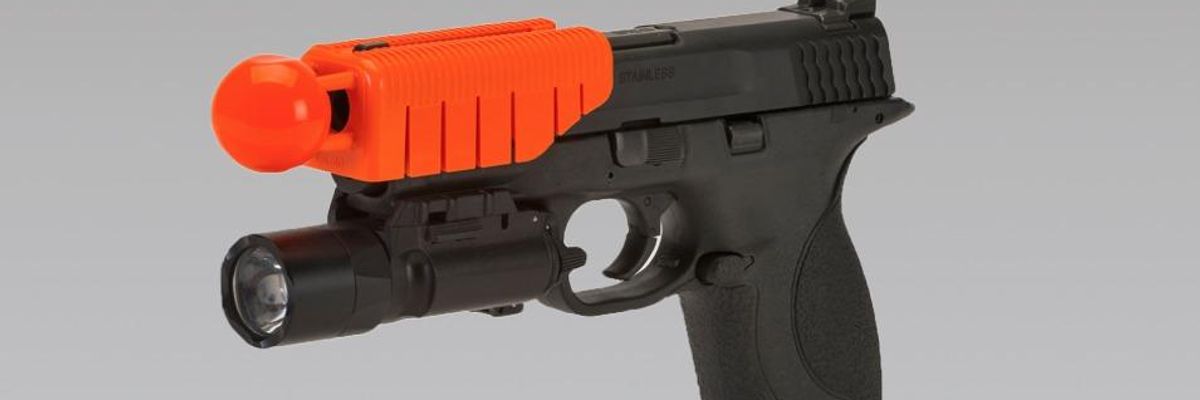Nearly six months after a white Ferguson police officer fatally shot unarmed black teenager Michael Brown, city law enforcement has devised a dubious response to the sustained protests that have swept this Missouri municipality.
They are calling it a "less lethal" gun attachment which purports to slow a bullet when fired, so that it wounds a person, potentially breaks a few ribs, but allegedly does not kill him or her.
Residents and organizers say that the newly-acquired weaponry, reported Wednesday in the Washington Post, merely serves to disguise and deflect from the brutality of a department where not a single officer has been indicted for the killing of Brown and law enforcement officials remain unapologetic.
"This 'non lethal' weapon is about different tools of a brutalizing police, not a solution to police brutality," Lou Downey, organizer with the Ferguson-based Stop Mass Incarceration Network, told Common Dreams. "Expanding the array of weapons to control and brutalize people doesn't change this logic--the logic of an occupying army, where black and brown youth are a subjected population."
At the behest of assistant police chief, Al Eickhoff, the Ferguson police department will begin this week to test the gun attachment, which is named "The Alternative," the Washington Postreported Wednesday.
Created by the California-based company Alternative Ballistics, the device is described on their site as a unit that sits in an officer's belt and can be attached to a gun. When the trigger is pulled, the bullet becomes embedded within the devise and both are fired as one. The process is alleged to slow the bullet and diminish "its penetrating energy," according to the company.
"The result is serious pain with less internal injury to the body than a conventional bullet," the company states.
Alternative Ballistics claims that the product has been "thoroughly tested," but its materials do not clarify whether such tests were independent, nor what public scrutiny its weapons have been subjected to.
According to the Post, Ferguson plans to eventually introduce the unit to its entire force.
"The Alternative" is part of the growing police arsenals nation-wide of so-called less-lethal and non-lethal weapons--from taser shotguns to sonic sound machines--which are often used against civilian populations, whether at mass protests or residential neighborhoods. Such weaponry has been accumulated alongside the increasing militarization of U.S. police.
As journalist Ando Arike pointed out years ago, so called non lethal and less lethal weapons are not unique to police departments, but are also employed by the U.S. military "against unarmed or primitively armed civilians; they are designed to control crowds, clear buildings and streets, subdue and restrain individuals, and secure borders. The result is what appears to be the first arms race in which the opponent is the general population."
Ferguson residents are no stranger to such weapons. Police and national guard troops have repeatedly used tear gas and rubber bullets to shut down demonstrations against racism and police brutality.
Michael McPhearson, organizer with the Don't Shoot Coalition and Veterans for Peace, told Common Dreams that this has led to "police escalations and use of violence to solve confrontations."
"People exercising their constitutional rights shouldn't be attacked at all," said McPhearson. "Violence is used against these communities when there shouldn't be any violence whatsoever."
Furthermore, the resourcing of new police weaponry goes against the demands of local residents, including the coalition Ferguson Action, which has called for the "repurposing of law enforcement funds to support community based alternatives to incarceration."
Organizers, ultimately, argue that new weapons ultimately do not address deep the racism, particularly against black communities, that has inspired nation-wide protests under the banner of Black Lives Matter--from Oakland to Ferguson to New York.
"The bigger problem and logic here is the program of the criminalization of whole generation of youth, especially black and latino youth," said Downey. "We've got millions of youth that the system has no future for."

